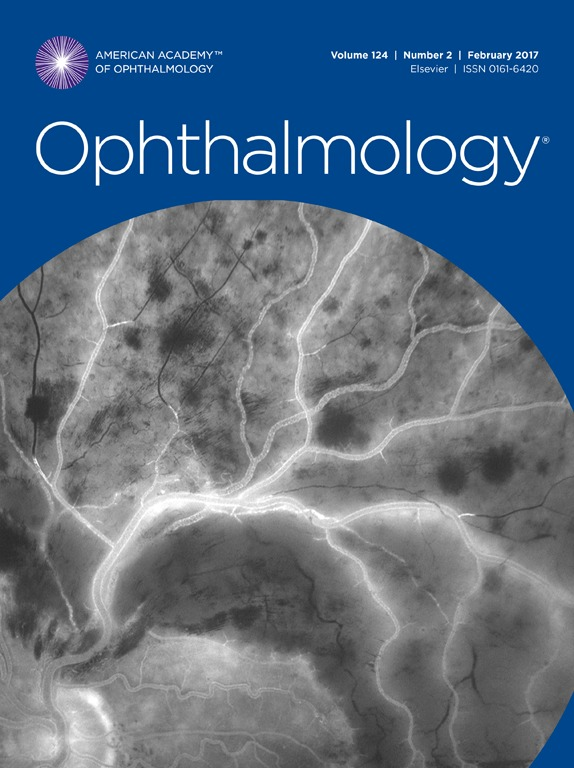小儿晶状体切除术和原发性眼内透镜植入术后五年内的近视度数变化
IF 13.1
1区 医学
Q1 OPHTHALMOLOGY
引用次数: 0
摘要
目的报告按手术年龄划分的初次眼内人工晶体(IOL)置入术后5年屈光不正的变化情况,并确定与5年后屈光不正变化相关的因素:设计:在 61 家儿科眼科诊所进行前瞻性观察研究:干预措施:主要结局指标:按手术年龄划分的屈光不正(球面等效)的五年变化(结果:平均球面等效近视度数的变化在 0 至结论年龄段进行手术时,平均球面等效近视度数变化(95% 置信区间 [CI])为-5.99 D(-7.64 至-4.34):在这项大型前瞻性队列研究中,年龄小于 13 岁的儿童在接受白内障手术并植入人工晶体后,其近视度数的变化更大、更不稳定。我们发现,术后即刻近视的眼睛在 5 年内的近视度数变化较小,这值得进一步研究,以便更准确地指导人工晶体功率的选择。本文章由计算机程序翻译,如有差异,请以英文原文为准。
Myopic Shift over 5 Years after Pediatric Lensectomy with Primary Intraocular Lens Implantation
Purpose
To report the change in refractive error over 5 years after primary intraocular lens (IOL) placement by age at surgery and to identify factors associated with the change in refractive error after 5 years.
Design
Prospective observational study at 61 pediatric eye care practices.
Participants
One hundred eighty-six eyes of 152 children undergoing primary IOL implantation before 13 years of age for nontraumatic cataract.
Interventions
Cataract surgery with primary IOL placement.
Main Outcome Measures
Five-year change in refractive error (spherical equivalent) by age at surgery and by immediate postoperative myopia versus emmetropia or hyperopia.
Results
Mean spherical equivalent myopic shift was –5.99 diopters (D; 95% confidence interval [CI], –7.64 to –4.34 D) when surgery was performed at 0 to younger than 1 year of age (n = 13), –3.53 D (–4.57 to –2.48 D) at 1 to younger than 2.5 years of age (n = 28), –1.91 D (–2.55 to –1.26 D) at 2.5 to younger than 4 years of age (n = 36), –2.04 D –2.60 to –1.49 D) at 4 to younger than 7 years of age (n = 60), and –0.83 D (–1.27 to –0.40 D) at 7 to younger than 13 years of age (n = 49; P < 0.01 for each comparison with the oldest group). Variability of myopic shift also decreased with increasing age (P < 0.01). In eyes of children 4 to younger than 13 years of age (small sample size precluded analysis of children younger than 4 years), significantly less mean change in refractive error was found over 5 years in eyes with myopia immediately after surgery (–0.69 D; 95% CI, –1.48 to 0.10 D; n = 27) than eyes with emmetropia or hyperopia immediately after surgery (–1.70 D; 95% CI, –2.10 to –1.31 D, n = 82; difference, –1.01 D [95% CI, –1.89 to –0.14 D]; P = 0.03).
Conclusions
In this large, prospective cohort study of children younger than 13 years undergoing cataract surgery with primary IOL placement, greater and more variable myopic shift was found in children undergoing surgery at a younger age. Our finding of less myopic shift over 5 years in eyes with unintended immediate postoperative myopia deserves further study to guide IOL power selection more accurately.
Financial Disclosure(s)
Proprietary or commercial disclosure may be found in the Footnotes and Disclosures at the end of this article.
求助全文
通过发布文献求助,成功后即可免费获取论文全文。
去求助
来源期刊

Ophthalmology
医学-眼科学
CiteScore
22.30
自引率
3.60%
发文量
412
审稿时长
18 days
期刊介绍:
The journal Ophthalmology, from the American Academy of Ophthalmology, contributes to society by publishing research in clinical and basic science related to vision.It upholds excellence through unbiased peer-review, fostering innovation, promoting discovery, and encouraging lifelong learning.
 求助内容:
求助内容: 应助结果提醒方式:
应助结果提醒方式:


